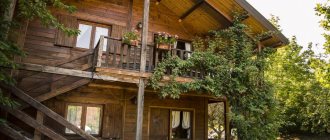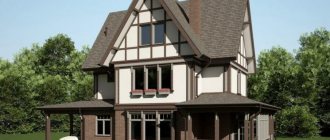Projects: Cottages - Houses - Cottages - Baths - Ancient projects - Estates - Combined houses
The living conditions of the present time have created a special type of owners who strive to build their own “nest” at minimal cost.
As always, demand caused supply, and entrepreneurs appeared to sell small plots of land in the immediate vicinity of the capital. The buyers of such land plots are in most cases working people who do not have large funds and therefore strive to build themselves a dacha or a house in the most economical way possible.
Meeting this aspiration of the majority, I offer to the attention of the respectable public a real collection of projects for inexpensive summer cottage buildings. Each of the projects proposed in this issue should be considered as a scheme that can be changed at will without causing unnecessary costs.
The method of building dachas, practiced today in the vast majority of cases, comes down to a simple deal with a contractor, often an illiterate person, who carries out the construction at his own peril and taste, inherited from the same predecessor, and the result is a worthless dacha with a barracks-chest look at best decorated with various decorations in the false Russian style with cockerels and horses. The purpose of this collection of architectural projects of dacha buildings is an attempt to streamline the matter of building dachas, introducing the public to the elementary requirements of grace in architecture and the fundamentals of the art of construction, and at the same time to provide several typical plans for buildings convenient for living, plans that can be changed at the request of everyone according to his requirements and aspirations.
A.V. Galanin, A.V. Belikovich © 2011
“I'm so tired of being on someone else's side. They started driving up to Vologda, I can’t take my eyes out of the window. Our houses are northern. The people are ours, so to speak, ours.” (F.A. Abramov. “Home”)
What is a Russian style house? This is, as a rule, a wooden, one- or two-story house with a three-pitched (less often hipped) roof, an obligatory light (and sometimes two) in the attic, always with a hemmed cornice. The house can be five-walled or four-walled, consist of one hut and an extensive entryway, or two huts - front and back, between which there is an extensive porch and entryway, and all this under one roof. A Russian house may or may not have a veranda. The area around a Russian house, as a rule, is not surrounded by a solid fence made of boards; a front garden made of a palisade for growing flowers is possible near the house.
We believe that the Russian type of house appeared in ancient times and was protected by tradition. It was part of the Russian national culture. Unfortunately, our ethnographers did not pay attention to houses built in this style. But until the 60s of the twentieth century, these houses predominated in Russian villages. In these primitive drawings we tried to show the main differences between a Russian house and a Novgorod-type house.
| 1 - places for attaching rafters on external logs of the upper crown of the log house 2 - external logs of the upper crown, into which the rafters of a Russian house are placed 3 - front wall of the house 4 - rear wall of the house |
In the photo on the left you can clearly see the cornice and the fact that the rafters are attached to the external logs of the upper crown of the log house, and not to the walls. The roof of a Russian house looks a little like a cap, and the roofs of houses of the Novgorod-Ilmen and Finno-Ugric types look like a knitted hat pulled deep over the ears.
| The Russian type of houses is widespread over a vast territory from the White Sea and the Kola Peninsula to the Oka River and from the upper Kostroma River basin to the upper Mologa River basin. Where did the Russian type of house first appear? When, how and by whom did it spread over such a vast territory? These questions require answers; they are important for understanding the history of Rus'. We believe that the Russian type of house arose on the southern coast of the White Sea a very long time ago, created by the Varangian-Rus ethnic group. The Russian style began to spread to the south in the 9th-10th centuries, when the Varangian Rus were either invited to reign in Ladoga, or seized Ladoga and Belozero by force in order to control water trade routes. Now we can only make hypotheses about this. Of course, the boundary of the area of Russian houses we drew requires clarification, but we have no doubt that Novgorod on Ilmen, Pskov, Vitebsk and Smolensk are located to the west of this area. To the south of the Oka, Russian houses are also practically not found. |
Gorodets
According to experts, one of the best Russian carved buildings is the log house in the center of folk crafts in Gorodets.
Of course, this beautiful creation was created by the hands of modern craftsmen, but at the same time it impresses with its beauty. Each building in the crafts center is a separate workshop (for embroidery, painting, icon painting). Master classes are held within the walls of each of them for visitors. Isn't it true that the carved complex is impressive?
Love advice from Princess William: words worth thinking about
Analysts have found out where Russians are going to fly for the May holidays
Seeing a starling means wealth: the first starlings returned to Moscow after winter
Yaroslavl region
| The village of Koza in the north of the Yaroslavl region at the beginning of the twentieth century. This is a trading village in which many wealthy merchants and peasants lived. In the photo we see confirmation of this - a fair in the central square. Today there are no these houses in the village, their owners were dispossessed in the 30s and disappeared in the Gulag, and the houses fell into the hands of lumpen people who did not repair them, which is why the houses collapsed. In their place, huts were built that were not at all in the Russian spirit. | Yaroslavl region. Russian houses with shutters on the windows are rare. The decoration of the platbands is also not slit (not lace). Otherwise, this house corresponds to all the canons of a traditional Russian house. |
| House in the village of Gavrilovo, Uglich district, Yaroslavl region. The house was built in the second half of the twentieth century. I would like to ask the owner: why did he build the house in the Russian style? Did he do this consciously or because his parents lived in such a house, he grew up in it, and this type of house is harmonious with his soul? | House in the village of Kablukovo, Uglich district, Yaroslavl region. The house has been abandoned by its owners. The old people, in all likelihood, died, and the children were forced to work and live in the city. Perhaps the current owners of the house come here to spend their holidays, and the older they get, the more they want to settle here permanently. |
| House in Pereyaslavl Zalessky in the south of the Yaroslavl region. The owners left this house and use it as a summer house. But it's better than quitting completely. But I want to find real owners for the house, who will live in it permanently; they will arrange a front garden, paint the walls and trim. | The village of Semenovskoye in the north of the Yaroslavl region. This house was built for teachers in the mid-60s of the twentieth century. It is strange that the house was made in the Russian style, because government houses were not built in the Russian style during the Soviet period. Photo from the mid-twentieth century. |
The city of Romanov-Borisoglebsk (now Tutaev). Procession. Photo from the beginning of the twentieth century. Two poor houses in the Russian style are visible. I note that in the city it was no longer possible to do without a solid fence. | City of Tutaev. An old brick house in Russian style. This house is at least 200 years old. |
| City of Romanov-Borisoglebsk. A slightly rickety Russian house next to the temple. Photo from the beginning of the twentieth century. | The city of Romanov-Borisoglebsk at the beginning of the twentieth century. The photo was taken from the bell tower. Look how many houses were built in the Russian style: gable roofs, light rooms, no solid fences, vegetable gardens. |
This two-story house is also in Romanov-Borisoglebsk, a brick house with a balcony. But the light reveals a Russian style in him. Judging by the blank fence, the house was built by a wealthy Russian merchant in the 19th century. | Russian house in the city of Poshekhonye. Once upon a time this city was not a backwater; an important waterway from Sheksna to Sukhona passed through it. But already in the 18th century, with the advent of the land road from Yaroslavl to Vologda, Poshekhonye found itself on the sidelines from active trading life. |
| House in the village of Frolovskoye, Myshkinsky district, Yaroslavl region. This house is at least 100 years old. A lot of these two-story houses were destroyed in the 30s of the twentieth century during collectivization and dispossession. Large houses belonged to wealthy wealthy people, who were all repressed. Left without owners, the houses began to collapse, they were occupied by lumpen people who were not very hardworking; in some cases, various offices, reading huts, clubs, and warehouses were located in the houses. Without proper protection, many of them burned down. Many of these houses were dismantled and burned for firewood. This information A.V. Galanin received it from reliable sources - from his grandmother and mother. | This house was built at the beginning of the 19th century and is at least 200 years old. It was probably built by a middle-income merchant, not of the first guild. As a rule, servants lived on the first floor of such two-story houses, and the owners themselves lived on the second. There was a summer room in the attic, remember the song: “In the attic under the roof, the accordion plays louder, sometimes quieter...” |
House of N.A. Morozov in the family estate of the Morozovs. Borok (Yaroslavl region). Today this estate is on the southern shore of the Rybinsk Reservoir. A nobleman, a member of the People's Will, a self-taught scientist, Nikolai Alexandrovich was truly a man of genius. Unfortunately, his name has almost been erased from Russian history. | The village of Zakobyakino in the north of the Yaroslavl region, 35 km from the homeland of A.V. Galanina. These houses, judging by the brickwork, are more than 150 years old; they were built by Zakobyako merchants in the middle of the 19th century. Zakobyakino was then a large, rich trading village. Many houses have a typically Russian style. |
House in the city of Tutaev (formerly Romanov), Yaroslavl region. This is a real masterpiece of Russian house-building. Svetelka, two-story veranda, balcony, but still the general style of the house is Russian. Once upon a time, the city of Romanov competed with Yaroslavl. But for some reason the city was renamed many times. First, in the 11th-12th centuries, the city of Borisoglebsk (named in honor of saints Boris and Gleb) arose on the high right bank of the Volga; later (in the 15th century), on the low left bank opposite Borisogleb, the city of Romanov appeared, named in honor of Prince Roman. Under Soviet rule, Romanov was renamed Tutaev, since Tsar Nikolai Romanov was overthrown, and many thought that the city of Romanov was named after the Romanov dynasty. | The village of Nikolo-Gora in the north of the Yaroslavl region: this is how it looked at the beginning of the twentieth century, even before the revolution. Almost all the houses in the village at that time were in Russian style. Today there are very few Russian houses left in this village; mostly houses are built with gable roofs - it’s easier to build that way! |
Yaroslavl region It is a well-maintained residential house, but it is only used in the summer as a summer cottage. | Yaroslavl region Residential well-kept house with original platbands. Covered with board, therefore warm. |
The village of Pogorelovo, Rostov district, Yaroslavl region. They do not live in the house permanently; the owners are here only in the summer. The foundation under the veranda has collapsed, the glass in the light room is broken, the paint is worn out. The house is waiting for a real owner who will live in it permanently. | Yaroslavl region, village. Rakhmanovo. Something distantly Aryan emanates from the name of the village. And the house is falling into disrepair... |
| Yaroslavl region, Pereyaslavsky district. Judging by the coloring of the walls, cornice and trim, the owners visit the house quite often, but do not live in it permanently. | Yaroslavl region. One house was built in a typical Russian style, but the second was not. Although it cannot be considered the Novgorod style. The rafters are not installed on the wall, but on the extended logs of the upper crown. Such a cornice is also not typical for Novgorod-type houses. |
Village of Khludovo, Yaroslavl region. And this house reeks of some kind of uninhabitedness and dreary loneliness. Although everything seems to be in place: the fence, electricity. | The village of Trufantsevo, Yaroslavl region. This house is completely abandoned. The window of the lighthouse has already been broken, the paint on the frames has completely faded, and the area of the front garden and vegetable garden is overgrown with bushes. The house resembles an old lonely woman whose husband died and her children abandoned her. This is how Russia is today. |
Noble mansion
You may be interested in: What is acquisition?
The highest nobility in the cities built luxurious mansions, the construction of which attracted famous architects. Numerous family members and servants lived in them. On the ground floor there were utility rooms and servants' rooms. The second was occupied by several large living rooms, boudoirs and bedrooms. The third floor housed living quarters with low ceilings.
Mandatory attributes of mansions and estates were special rooms, the purpose of some of them is not entirely clear to modern people:
- Hallway. These premises could be found exclusively in Russian mansions and houses. In cold winters there was a large amount of outer clothing, which had to be removed and placed when entering a warm room. European houses do not have hallways. The place where fur coats, hats, and warm shoes were hung was fenced with railings. There were mirrors hanging here and chairs.
- The valet room, so named due to the fact that there was a valet on duty there. It was furnished with good quality mahogany furniture. The walls were decorated with paintings.
- Portrait room. Here on the walls hung portraits of family members or ancestors. The furniture was made of mahogany. The walls were painted in natural colors or covered with wallpaper. Often they were covered with designs imitating wallpaper.
- Cabinet. It was mandatory in 19th century noble houses or estates. As was customary, furniture was made from Karelian birch, poplar or mahogany. The walls were covered with wallpaper or painted to match it.
- Dining room. A large room where the owners dined and treated their guests. It was decorated with a large oval table, expensive furniture and paintings on the walls, which were painted in natural colors.
- Bedroom with boudoir. The hostess slept here. The bed was covered with a screen; in the corner there was usually an icon case where one could pray. The boudoir was separated from the bedroom. In it, the housewife could take care of her toilet and business: embroidery, correspondence. As a rule, there were other bedrooms for family members and guests in the house.
- Living room. The front room where guests were received. It was richly furnished, paintings hung on the walls, and upholstered furniture was installed for relaxation and conversation. The living room in the house of a 19th century nobleman was arranged in accordance with the prevailing style. It was a time of classicism with a clear rhythm and a unified style of placement of furniture and art objects. Mahogany furniture was decorated with chased items made of gilded bronze or brass. The French fashion for antique products implied the presence of statues that were located in living rooms. The decor of the room matched this. In a rich nobleman's house in the 19th century, where many guests were received, there were several living rooms.
You may be interested in: Institute of the Ministry of Emergency Situations in Minsk: address, faculties, passing grade
Foreigners were surprised by the double frames on the windows, large stoves reaching to the ceiling, decorated with beautiful tiles. The fireplaces were not lit in winter. Because cold air penetrated through them. They were closed for the winter and decorated with flowers. Foreign guests were also surprised by the huge number of flowers in the houses; they were everywhere.
Kostroma region
| Pogatikha village. At the beginning of the twentieth century, this house was built by a wealthy peasant. Over the course of 100 years, the foundation of the house has sagged a little, but otherwise it is perfectly preserved. Unfortunately, the owners abandoned it, but the house is still habitable. How many homeless people today wander around the cities of Russia, living in sewer wells and basements! At the same time, there are so many abandoned houses in Russia that are quite suitable for living. | Kostroma region. A rich house in an elaborate Russian style. |
p. Bor. The abandoned house requires minor repairs; the front garden needs to be tidied up and the roof covered. After all, the main reason that people leave villages is the lack of work - unemployment. And our people lost the taste for independent living on a semi-subsistence economy during the years of Soviet power. We think that when the unemployment rate in cities rises to 20%, then people will move to the countryside. But this will already be a generation of people of a new, non-Soviet generation. In the best case scenario, the revival of the Russian village will take at least 50 years | Kostroma region. Svetelka looks like a house, and also like an elegant girl in national Russian clothes. This house in the Kostroma region can no longer be restored. |
| A poor Russian house in the Kostroma region. However, in terms of area, this house can be equated to a full-size 2-3-room apartment in a high-rise building. But here there are no neighbors who are boring you to death, here you can hit the wall with a hammer whenever you want, and play the button accordion or piano all day long, as long as your relatives don’t object. To grow potatoes and vegetables, you don’t have to travel 50 km out of town on a crowded bus or train. | Chukhloma, Kostroma region. Here lies the eastern border of the distribution area of Russian-style houses. |
The outskirts of the ancient city of Soligalich. This is the northeast of the Kostroma region. | A modest house with three windows on the facade, and how decorated with carvings! When you look at such a house, your mood improves - your soul sings. To live in such a house is impossible to be evil and mean. |
Features of Russian architecture of the 19th century
Russian architecture of houses of the 19th century predetermined the appearance of modern cities. In the first half of the century, the dominant trend was classicism with its rigor, order and clear layout. He embodied the ideas of antiquity, the rigor of canons and logic. Its main feature is the Tuscan order, which is enlarged and emphasized by the severity of massive walls, colonnades and arches. This applied to both urban planning in general and individual buildings. It was replaced by eclecticism - a mixture of elements of different styles.
Vologda Region
A huge two-story Russian house in the Vologda region. Even at the beginning of the twentieth century there were many such houses in Rus'. Large families lived in them; there was enough room for everyone. The fact that one family lived in the house is evidenced by one chimney on the roof. The owners were not poor, since they could afford to build and maintain such a house. | The village of Novlenskoye at the beginning of the twentieth century. All houses are built in Russian style. Houses are sheathed with planks for insulation. Only wealthy people could afford this. I doubt that a poor country could afford such construction. |
The village of Novlenskoye at the end of the twentieth century. The oldest of all Russian houses existing in the village of Novlenskoye was built in the 50s of the 19th century, and perhaps even at the beginning of the 20th century. | House in the village of Novlenskoye, Kubenskoye Lake. Once upon a time these were the lands of the Bokhtyuzh principality, which played a key role in the history of Rus'-Russia. Unfortunately, historians still doubt that this principality actually existed; the environs of Lake Kubenskoye are now a very remote place. But once it was a junction on the trade route from Sheksna to Vaga and further along the Northern Dvina to the White Sea. |
And this house has been abandoned by its owners. He dies and sadly looks at the white light through the empty eye sockets of the windows. How happy this house will be if it finds owners! But it is quite possible to repair it... | The village of Ustyuzhna, Vologda region, is located in the Mologa River basin. Just west of Ustyuzhna lies the western border of the distribution area of Russian-style houses. |
| Something very significant has broken in our state. | Today in Russia there are many abandoned cities, towns and villages. Your heart aches when you see this. This is the death of Rus'. This happened only in the Time of Troubles of 1612, when the population decreased by 3/4. |
| Two houses - two destinies. How many homeless people are there in Russia today, with families huddled in 10-12 square meters? meters of stinking hostels, hotels and apartments with additional accommodation. At the same time, in beautiful villages and villages, beautiful abandoned houses stand and are destroyed. The rulers of the country should change the mode of interests and life attitudes of citizens so that they see their prospects in such villages. | The village of Ustye Vologodskoye at the mouth of the Kubena River, which flows into Lake Kubenskoye. The house was built in a typical Russian style at the beginning of the 19th century and once belonged, in all likelihood, to a wealthy merchant. Here, from this village, the waterway began along the Kubene, Vaga and Northern Dvina rivers to Kholmogory to the White Sea. |
Noble estate
An estate is a complex that included a residential building and various buildings: utility, gardening, stables, human and others. They fit harmoniously into the manor park. If there was no river nearby, then a lake with an island was built, alleys were laid out, rotundas were erected, ruins and grottoes were laid out. Rich estates had a church. Manor houses were arranged according to the principle of city mansions.
There is such a thing as Russian estate style. It is quite unique; it was difficult to see anything similar outside Russia; the specifics of this style were determined by serfdom and long distances from large cities. The estate had many workers who lived here. Isolation from the city left its mark, as the nobles had to take care of the household and constantly communicate with the peasants.
Rare trips to district or provincial towns were a real event. Other estates were located tens of kilometers away, so guests did not come often. Furniture purchased after the construction of the house was passed on to the heirs. Fashion and style news arrived here late. But there were estates that were built by famous architects, some of which have survived to this day. These are real monuments of Russian architecture.
Moscow, Vladimir and Ivanovo regions
Russian houses were different: rich, poorer, poor. But all of them were made in the native style, in harmony with the soul of the Russian person. | Every Russian house is not just a dwelling, it is a work of applied art. The whole life of a Russian person was permeated with beauty. Such a house reminds me of a Russian beauty: the windows are eyes, the frames are eyelashes, the light is “and a star is burning in the forehead.” |
A Russian house on the outskirts of Moscow is living its last days. Rus' disappears, and in its place something satanic, something not Russian, appears. | The village of Shchelkovskoye, Moscow region. Typical Russian house. |
| In the south, life was easier, the Russians who moved here had more free time, and the descendants of settlers from the north began to decorate their homes, and so skillfully, as we see in the example of this house in the Ivanovo region. | Ivanovo region, abandoned houses. There is an asphalt highway running through the village, there is electricity, connect and live. But there are no people, Rus' is dying out, tortured by political, economic and social experiments. |
Vladimir region. And in the southern regions of Rus', houses were not always decorated with carved platbands. The house was abandoned by its owners. And it could perfectly accommodate two full-fledged families. Vegetables from your own garden, mushrooms and berries from the neighboring forest, water from your own well. | Vladimir region. A modest version of a Russian house. But it’s much more comfortable to live in it than in a room in a communal apartment, for which the utility services charge you a fee equal to your pension. In addition, there are constant clashes with a neighbor who is a cat lover and a neighbor who is a dog lover. Well, why doesn’t a modern person want to be free from scammers in housing and communal services, not to depend on traffic jams, not to eat nasty food in beautiful packages and not to drink stinking water from rusty iron pipes? |
Russian houses were built according to a single plan (a certain style), but each owner decorated his house in his own way. | Patterned panels at the corners of the house are a typical decoration of Russian houses. But the drawing can be completely different! |
House in the village Pistsovo, Komsomolsky district, Ivanovo region. All corners and bands are trimmed and decorated. A birch tree grew in the front garden and covered all the beauty (or maybe, on the contrary, emphasized all the charm of the Russian village?). | Decorated house in the village. Krutovo, Ivanovo region. Notice how the boarded corners are decorated and how free the front of the house is. |
This house is lucky. It has owners, and they live in it. See how happy this house is, it simply shines with happiness. | The city of Yuryevets, Ivanovo region. The stone two-story house was built in the 18th century. Rich Russian people could have built such a house for themselves, and it seems that there were many such people in pre-revolutionary Russia, including among people of Russian nationality. |
Tver and Novgorod regions
The village of Kimry, Tver region. A typical Russian house in an “ascetic” version. The owners have left the house, but it is in perfect order and ready to accept new residents. Judging by the fact that none of the corners have rotted or fallen off, this house is no more than 40 years old. | The village of Kimry, Tver region. A typical Russian house, but in a southern red-decorated version. The house is residential and that’s probably why it’s so cheerful. The strange name of the village is Kimry. Was it not from the Cimmerians that the village got this name? |
Tver region, Shchegolevo village, abandoned Russian house. Abandoned houses are like dogs abandoned by their owners. | Tver region, Rzhevsky district. Russian house. |
| House in the village of Berezaika, Tver region. The house has owners, and it seems they don't want to leave their home. After all, everything here is yours, everything is native, take this apple tree for example. | Tver region, Lyakhovo village. Living (residential) Russian house. But a blind fence is no longer in Russian, but in modern times, when a person is not a friend to a person, but an ill-wisher, a wolf (enemy). |
Eastern part of the Novgorod region. After looking through several hundred photographs of rural houses in the Novgorod region, we found only two built in the Russian style. This alone proves that the Novgorodians did not come to the White Sea from Ilmen. Otherwise, how can this fact be explained? | Syabrenitsy village, Novgorod region. In this Russian house from 1881 to 1882. Democratic writer G.I. lived with his family. Uspensky. This democrat probably had a Russian soul. And the house has been standing for about 150 years! |
Bourgeois house
The bourgeois class included teachers, day laborers and hired workers. They made up the majority of the population of cities, and their numbers became especially large after 1861, when serfdom was abolished. The housing of the bourgeoisie was rented or a modest house of their own. Most often they were small, built like rural houses. Their styles corresponded to the area where they lived.
Nizhny Novgorod and Ryazan regions
And this house is in the Nizhny Novgorod region in the village of Shakhunya. | Nizhny Novgorod region, Bogorodsky district. The house may be brick, but it is Russian. I wonder where the ethno-social information is stored about how to build houses, about the fact that it is awkward and indecent for a Russian person to make solid fences near the house? When someone borrowed money from a Russian, it would never have occurred to him to demand repayment of the debt with interest. A Russian person would collapse from shame. This is where the Russian world differs from the non-Russian world. |
| Nizhny Novgorod. The house is brick, but built in the Russian style, which, by the way, is very characteristic of the Nizhny Novgorod region. It was alien to Russian people to build blank fences near their houses. Since ancient times, Russians lived in a community; in the community they were embarrassed to show distrust of each other, so not only did they not build fences, but they also did not have locks on the doors. | Nizhny Novgorod region, Borsky district, Pumra village. Nizhny Novgorod is the southeastern border of the area of Russian-style houses. |
| The village of Bolshoye Murashkino, Nizhny Novgorod region. | The village of Bolshoye Murashkino, Nizhny Novgorod region. The house is made of brick, but the platbands are still there, the light is decorated with intricate carvings. “The Russian spirit is here, it smells like Russia.” |
Vasilsursk, Nizhny Novgorod region. The southeastern border of the distribution of Russian houses. Behind it begin the houses of the Mari and Chuvash... | Nizhny Novgorod region, Vachsky district, Filinskoye village. |
| The village of Gorbatovka, Nizhny Novgorod region. Now in the Nizhny Novgorod region it is very expensive to build a house from logs, and in the southern half there are almost no forests, but there are a lot of brick factories, so they build from bricks. In addition, brick houses are more resistant to fire. But a brick house can also be built in the Russian style. | The city of Gorokhovets, Nizhny Novgorod region. The house was built in the Russian style, but the fence is blank, although you can approach the gate directly from the street. In the courtyard you can see some strange structure - a round tower, which probably has a “cult purpose”. |
The village of Kalitka, Vorotynsky district, Nizhny Novgorod region. An old merchant's house, built, judging by the brickwork, back in the 18th century. Built in typical Russian style. If the brickwork had been done in the 60s of the twentieth century, then half of the bricks would have already fallen out. | Ryazan Oblast. Houses of the Russian type are rare in this area and only in the northern part in villages on the Oka River. We assume that the southern border of the range of Russian houses runs along the Oka. |
| House in the Ryazan region. Pay attention to the original architraves and the overhanging roof over the lighthouse. | House in the Ryazan region. A new brick house with an iron roof - but quite in the Russian style! |
We think that in the time of Sergei Yesenin his home was simpler than this. Today this house is a museum of the great Russian poet. The main thing is that Yesenin’s house-museum was built in a typical Russian style, with carved platbands and cornices, with lilacs in the front garden and without a solid fence - truly in Russian. | The village of Zhestelevo, Pavlovsk district on the Oka River. It's a brick house, but the roof is made in the Russian style. Oka is the southern border of the area of Russian-style houses. We looked at many sites that posted rural houses located in the Ryazan region, but found only five. |
Merchant's house
The development of capitalism has led to the emergence of free capital that requires investment. The rapid construction of houses by large merchants and manufacturers begins. Merchant houses of the 19th century, owned by very rich representatives of this class, were mostly similar to palaces. Famous architects were often invited to the construction.
But for the most part, merchant houses were good-quality wooden, wood-stone and stone, which overlooked the garden and vegetable garden. The courtyards were adapted for storing goods, the furnishings were very different, there is no need to talk about any style here. Along with the paintings purchased for the occasion, there were many icons. They sought to imitate the representatives of the upper classes in everything. But for the most part, only a few succeeded, those who received a decent education.
The nobility slowly went bankrupt, selling their estates. The merchant class grew rich and bought them, adapting them to their own way of life. But most of the nouveau riche taught their children not only in Russia, but also abroad. It was already difficult to distinguish the well-educated merchant children from representatives of the upper class. They arranged their 19th century homes in Russia differently than their fathers. They knew several languages, understood painting, architecture, and literature.
Women's corner (Seda)
This was an important space in a girl’s life. After all, it was from behind the curtain that the young lady came out in her festive attire when the groom and his in-laws came to the bride's party. There she waited for her betrothed on the wedding day. In the “middle”, women gave birth to children and breastfed them, away from prying eyes.
If a girl liked a guy, then in the “middle” of his house, she hid a sweeper in order to get married in the near future. There was a belief that such a ritual would help the daughter-in-law get along with her future mother-in-law and become a good housewife in her home.
Utensil
It is difficult to imagine a peasant hut without numerous dishes and household items. Utensils (cast iron pots, frying pans, clay patches) were stored in the oven or near it. But porcelain products were placed in a prominent place so that every guest could appreciate their beauty. It symbolized prosperity and was a source of pride for Slavic housewives.
Dishes for festive events were placed in the upper room, and plates were placed in the watch cabinet. Hanging shelves were used to store everyday utensils. Dinnerware consisted of a clay or wooden bowl, a spoon, a salt shaker made of birch bark or copper, and cups for kvass.
| Painted boxes, decorated colorfully and brightly, were used to store bread. This highlighted the item, symbolizing its importance and significance. They drank tea from a samovar. |
A sieve was used to sift flour. The most common utensil is a clay pot. They prepared delicious porridge and rich cabbage soup. The farm also used barrels and tubs for pickles.
They fried it in a frying pan and kneaded the dough in wooden containers. Buckets or jugs were used to store and carry water.
A grip was used to remove food from the oven. In the nineteenth century, clay pots were replaced by metal utensils called cast iron pots.
For eating, they used a bowl that varied in size. Often along the edges of the object there was a painting of floral patterns. For drinking, a wooden or clay mug covered with patterns was used.
Men's corner (Konik)
It was located on the right side of the entrance. A wide bench was placed here, fenced with wooden boards. They were carved in the shape of a horse's head, hence the unusual name for the male corner.
Under the bench the guys placed tools used for repairs or other work. In the “konik”, men wove baskets, created beautiful things from wicker, patched shoes and repaired utensils.
All the guests sat down on the bench located in the corner, even those who looked into the house for a couple of minutes. Here the man slept and rested in his free time.
Stove corner
Sometimes it was called “woman’s” because it was here that household utensils were kept. To separate the corner, they used a regular fabric curtain or built a wooden partition.
| The men of the family almost never visited this area. If a stranger dared to look behind the curtain, he insulted the owners of the hut with such behavior. |
The stove corner was used for washing and drying clothes; here they cooked food, treated children and told fortunes. Almost every young lady in a Russian village was fond of some kind of needlework. And the quietest and most peaceful place, ideal for this activity, is the stove corner. Most often, girls were engaged in embroidery, painting, and sewing.










